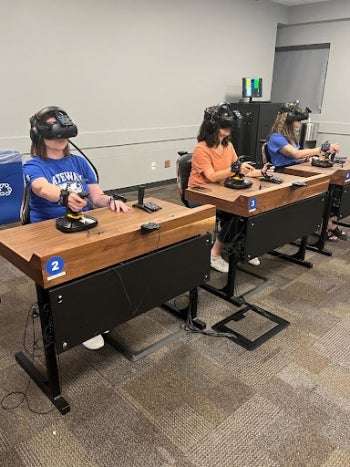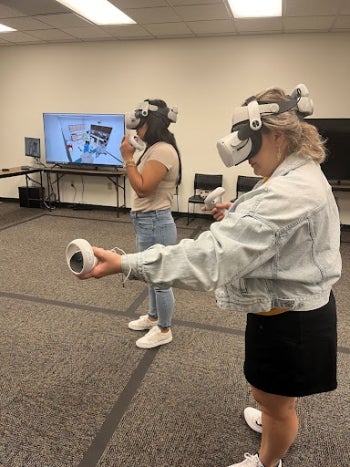Enhancing the transfer experience through innovative solutions and technology
Community colleges seek to learn about ASU's opportunities for transfer students
Strengthening relationships between the university and community colleges, Academic Alliances continues enhancing the transfer landscape by providing innovative solutions to increase student success, facilitate simplified transfer pathways, and ultimately support students in achieving their college degree goals through 220 community college partnerships nationwide and growing.
And with state-of-the-art tools available to students, receiving a nationally ranked education from Arizona State University is now more accessible than ever before. Tools such as MyPath2ASU, ASU’s transfer pathway program designed to help students easily navigate the transfer process through personalized transfer maps to more than 400 ASU on-campus and online bachelor degree programs, have transformed the transfer experience for over 35,000 users so far.
ASU’s integration of virtual reality and simulation tools has further transformed the ways curriculum is taught and how students learn. These experiential learning opportunities have resulted in incredible success in learning outcomes and overall student engagement. So much so that ASU has incorporated virtual reality innovations such as Dreamscape Learn, a partnership between Dreamscape Immersive and ASU that creates immersive learning course materials, into all introductory biology courses to now include Dreamscape Learn labs as well.
According to RaeAnn Fox, senior director for Dreamscape Learn and Realm 4 Project Initiatives at EdPlus at ASU, “Nationwide 48% of students drop, fail or withdraw freshmen year from STEM fields, and for ASU, that rate was about 37%, for biology in particular, with a traditional wet lab curriculum.” In an effort to decrease these percentages and with over 13,000 ASU students taking intro biology courses every year, researchers sought to understand not only how well students learn but also their levels of engagement when utilizing immersive virtual reality in place of traditional intro biology labs.
Currently beginning year three of a five-year longitudinal study, “Researchers have found students enjoy the virtual reality experience throughout the course, with the average student rating a 4.5 out of a 5-point scale. Students were also 1.7 times more likely to receive an ‘A’ on their assignments than students participating in traditional wet lab sections. Plus, the more students attend VR labs, the more they reported feeling engaged in the course, and this was seen over multiple semesters.”
Academic Alliances continues to receive requests from community colleges to visit ASU to experience how these innovative learning solutions are integrated into the student experience for themselves.
Recently, leadership and faculty from GateWay Community College, interested in Dreamscape Learn and how community colleges can adapt these technologies into their own operations, visited the Tempe campus to learn about ASU’s virtual reality offerings.
“Using this type of technology is integral when it comes to training the workforce of the future.” says Kristen Gubser, associate vice president of Workforce Strategies and External Affairs at GateWay Community College. “We currently do some VR training in our workforce programs, in Allied Health specifically, in medical radiography. We also do a lot of simulation in our nursing programs, in all our healthcare programs, and also in some of our trade programs such as welding. But being able to take what we’re doing in simulation and adding VR and AI to make those experiences hands on and immersive to students is really important and also helps us to give people real-world work experiences without requiring them to do clinical rotations that are often hard to find for students, which can delay the time to completion. So being able to integrate VR into more of our workforce training programs will make better employees in a faster amount of time than we’re able to produce right now.”
Gubser continues, “Of the Maricopa Community Colleges, GateWay Community College is known as the innovative community college, and we have the most robust offerings of occupational and workforce programs. And with ASU being known nationwide and internationally as the most innovative university, incorporating these futuristic technologies into all of our training programs will help our students be well prepared when they continue in their education at the university level because they will have already been exposed to this, and that will of course help them feel more comfortable when they move into the university space and as they continue to move up their career path.”
Brad Johnson, GateWay Community College faculty and program director of the Radiologic Technology program, further shares how these types of immersive technologies enhance learning outcomes. “When I think about how we are currently using VR software in radiography, which is a fully immersive experience for students, there are things they can do in the VR world that they can’t do in the real world. From a teaching standpoint, using this in a classroom space helps demonstrate concepts to students that are sometimes more theoretical in nature or difficult to experience. Coming to a space like Dreamscape, to see everything that they offer, it’s amazing, and it makes me excited in a way that I think about how to more fully integrate the sequence of lecture, VR lab and physical lab, and using a combination of those three to really help a student understand the concepts being taught.”
At Central Arizona College, an influx of new advising staff and a competitive nursing program also led to their interest in visiting the Downtown Phoenix campus to learn about ASU’s nursing and healthcare degrees, and to experience the virtual reality and simulation labs designed for students in the College of Health Solutions and Edson College of Nursing and Health Innovation programs.
“The College of Health Solutions, in collaboration with the Edson College of Nursing and Health Innovation, developed the Virtual Reality Simulation Laboratory to train students in realistic health care scenarios in a controlled environment before facing the naturally unpredictable challenges of an internship, clinical placement or job. In one scenario, students interact with a child experiencing symptoms such as sweating, dizziness and a racing heart and must determine that the child is diabetic and experiencing hyperglycemia. The VR lab is an innovative way to help students bridge the gap between the fundamentals learned in the classroom and the practical knowledge acquired through real-world experience” shares Health Solutions.
Many Central Arizona College students signed up for MyPath2ASU are also on health-related transfer pathways, with the majority who transfer into a bachelor’s degree program, transferring to ASU. Dianna Davis, assistant director of Advising at Central Arizona College, says that their college has a large cohort of pre-nursing students who all complete the prerequisites for nursing. However, the college only has 30 openings in their nursing program each year — a small number compared to the number of applicants received.
“We wanted to be able to provide our students with an alternative incentive to finish an associate degree meeting pre-nursing requirements. And I know that Health Solutions provides a lot of alternatives for students to go into in the health fields, in addition to nursing or pre-medical majors. I think what they offer at ASU is great and provides students many other options, so if they’ve already finished their associate degree they can transfer, and this gives us the opportunity to show them all the options available and also gives our advisors the hands-on experience they can share with their students.”



